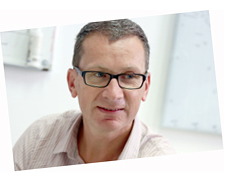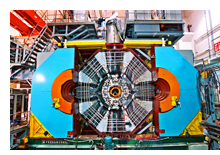|
25 November 2014
Subatomic particles, muons, quarks, gluons, and their cousins: Physicists working with the MAMI electron accelerator at Johannes Gutenberg University Mainz (JGU) are also playing an important role in the BESIII Experiment in Beijing in China. They are on the trail of the basic building blocks of matter and are thus hoping to pave the way for a New Physics.
 Professor Achim Denig draws three fat dots in a triangle shape on a blank sheet of paper. They represent the end points of an expedition that was launched in order to discover what constitutes the basic building blocks of matter. This expedition began by looking at molecules, those tiny objects such as the water molecule H2O. Of course, molecules are each composed of several atoms. "Each of these atoms has a nucleus," explains the physicist. "And a nucleus is composed of neutrons and protons." The sketch that Denig has just made is meant to be of a proton. "Of course this depiction is very simplified," he warns. The three dots represent three quarks. And indeed, quarks are dot-like particles without extensions. Denig now draws spiral-formed connections between them. "These are the gluons, the adhesive particles that keep the quarks together." Professor Achim Denig draws three fat dots in a triangle shape on a blank sheet of paper. They represent the end points of an expedition that was launched in order to discover what constitutes the basic building blocks of matter. This expedition began by looking at molecules, those tiny objects such as the water molecule H2O. Of course, molecules are each composed of several atoms. "Each of these atoms has a nucleus," explains the physicist. "And a nucleus is composed of neutrons and protons." The sketch that Denig has just made is meant to be of a proton. "Of course this depiction is very simplified," he warns. The three dots represent three quarks. And indeed, quarks are dot-like particles without extensions. Denig now draws spiral-formed connections between them. "These are the gluons, the adhesive particles that keep the quarks together."
Mysterious new particles
 Previously, physicists were only aware of the existence of subatomic particles composed of two or three quarks. That was until 2013, when PhD student Zhiqing Liu discovered a new subatomic particle that has been dubbed Zc(3900) while working with the BEPCII electron positron collider in Beijing, China. This particle has four quarks and although it only exists for a billionth of a microsecond, it has made a lasting impression on the scientific community. Previously, physicists were only aware of the existence of subatomic particles composed of two or three quarks. That was until 2013, when PhD student Zhiqing Liu discovered a new subatomic particle that has been dubbed Zc(3900) while working with the BEPCII electron positron collider in Beijing, China. This particle has four quarks and although it only exists for a billionth of a microsecond, it has made a lasting impression on the scientific community.
"The fact is that we still do not really understand how quark complexes function in protons or neutrons," says Denig. The discovery of Zc(3900) brings new insight that may help to complete the picture, a picture that is significantly more complicated than the rough sketch on Denig's desk. Zc(3900) is not the only new particle of this type. A little later, another PhD student, Yuping Guo, discovered a similar constellation and new ones are being added all the time.
Liu's and Guo's reports on their work were deemed the best and second best doctoral theses in physics in China. The American Physical Society placed the discovery of the new particles on their list of the ten 'Highlights of the Year'. Today both Liu and Guo are working as postdocs in Denig's work group, which is part of Collaborative Research Center 1044 "The Low-Energy Limits of the Standard Model: From Quarks and Gluons to Hadrons and Nuclei" that is sponsored by the German Research Foundation (DFG) at the Institute of Nuclear Physics at Mainz University.
350 physicists, eleven countries, one experiment
 "We want to find out what it is that holds matter together at its core," explains Denig, the co-coordinator of the Collaborative Research Center, summarizing the objective of his group in a single sentence. The physicists from Mainz have thus joined an international team of scientists who are running the BESIII Experiment at the BEPCII Collider. Originally the focus was on another particle with surprising properties that was discovered in 2005 at the SLAC National Laboratory at Stanford University in California: Y(4260). This discovery was confirmed within only a few weeks, but investigations brought to light other sensational findings. "We want to find out what it is that holds matter together at its core," explains Denig, the co-coordinator of the Collaborative Research Center, summarizing the objective of his group in a single sentence. The physicists from Mainz have thus joined an international team of scientists who are running the BESIII Experiment at the BEPCII Collider. Originally the focus was on another particle with surprising properties that was discovered in 2005 at the SLAC National Laboratory at Stanford University in California: Y(4260). This discovery was confirmed within only a few weeks, but investigations brought to light other sensational findings.
Participating in the BESIII experiment are 350 physicists from 50 institutions and eleven countries. "We are now the third largest group," reports Denig. "Five work groups in Mainz are involved and together with Professor Wolfgang Gradl, we act as the coordinators for the non-Chinese universities." The BEPCII electron positron collider is the ideal complement to the Mainz electron collider MAMI, with the help of which scientists can also perform unique experiments in order to explore aspects of the structure of subatomic particles. In addition, CRC 1044 is embedded in the Cluster of Excellence "Precision Physics, Fundamental Interactions and Structure of Matter" (PRISMA) at Johannes Gutenberg University Mainz, which offers additional opportunities. "The important work we undertake in Mainz is acknowledged around the world."
The teams meet four times a year in Beijing in China. "We also have teleconferences several times a week." And there is an active exchange of researchers as well – as in the case of Liu and Guo.
 Related link Related link
 BESIII Experiment BESIII Experiment
 Physics beyond the Standard Model Physics beyond the Standard Model
The scientists use high-precision physics to get to the fundamentals of matter. They look for inconsistencies in the Standard Model currently used to explain particle physics. "Essentially, we are looking to find something that does not quite fit as we will then know that there is something more than what the Standard Model is telling us."
But what might that be? The four fundamental forces of physics are well known. They are gravitation, electromagnetism, the weak atomic force, and the strong atomic force, which latter plays a role in the creation of particles such as Y(4260) and Zc(3900). However, the properties exhibited by certain subatomic particles provide indications that something else apart from these forces is at work – something that is not covered by the Standard Model. Denig and his colleagues are taking a theoretical and experimental approach in an effort to find out more.
"The Standard Model functions incredibly well," concedes the physicist. The model predicted the existence of the recently discovered Higgs particle. "However, we also know that there are some things that the Standard Model does not explain. This table, the moon, the sun, the universe – each of them is essentially composed of matter. But where the Standard Model falls short is that it does not resolve the problem of why there is now so much more matter than there is anti-matter. Immediately after the Big Bang the ratio was 50:50. In addition, the mysterious dark matter is also not described by the Standard Model although we believe it constitutes most of the matter in the universe."
Looking for the Theory of Everything
 That which applies on the large scale also applies on the small: the DFG Collaborative Research Center 1044 focuses closely on the anomalous magnetic moment of the muon. The muon is the electron's heavier brother and its magnetic moment deviates from what the Standard Model would lead one to expect. "To date, three to four standard deviations have been detected. Once five standard deviations are found, we would have proof that something is not quite right." Such proof would represent a further step towards the development of a New Physics, an entirely new approach that will take scientists further than the Standard Model does. That which applies on the large scale also applies on the small: the DFG Collaborative Research Center 1044 focuses closely on the anomalous magnetic moment of the muon. The muon is the electron's heavier brother and its magnetic moment deviates from what the Standard Model would lead one to expect. "To date, three to four standard deviations have been detected. Once five standard deviations are found, we would have proof that something is not quite right." Such proof would represent a further step towards the development of a New Physics, an entirely new approach that will take scientists further than the Standard Model does.
But why look for evidence like this, what is the point of the research? Denig is constantly being asked this question. "I have two answers. For one thing, we are undertaking exciting basic research, although some might see what we get up to as having little to do with reality. However, by sharing our top-level research with our students and young researchers, we can guarantee them an excellent level of training. Our work groups bring together Germans, Italians, Chinese, and Americans. They work on highly specialized technical problems and learn early on how to present their work at the international level. Our people subsequently have no difficulty at all finding a job in the private sector."
And the second answer? "It is very simple: we are looking for the Theory of Everything. And you can't get more basic than that. We are working at an unbelievably fundamental level."
 Read more Read more
 International research team discovers new exotic particle in the BESIII Experiment at the Beijing Electron Positron Collider (27 March 2013) International research team discovers new exotic particle in the BESIII Experiment at the Beijing Electron Positron Collider (27 March 2013)
 New Collaborative Research Center 1044: The Low-Energy Frontier of the Standard Model – From Quarks and Gluons to Hadrons and Nuclei (17 Jan. 2012) New Collaborative Research Center 1044: The Low-Energy Frontier of the Standard Model – From Quarks and Gluons to Hadrons and Nuclei (17 Jan. 2012)
|




 Related link
Related link 

